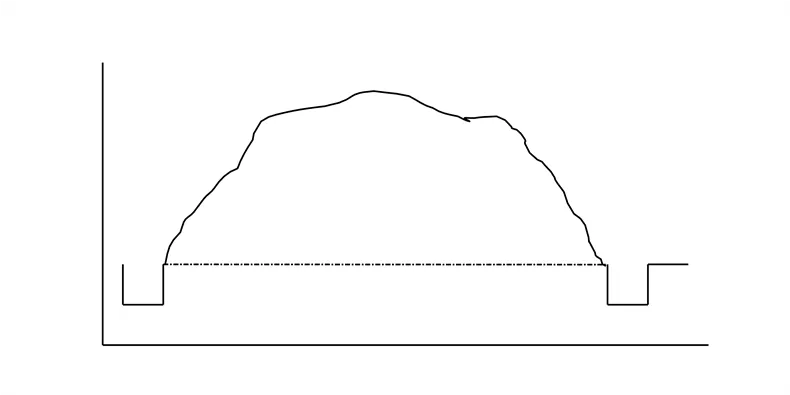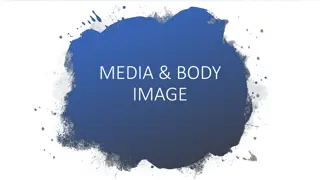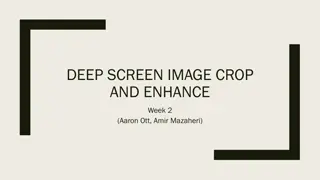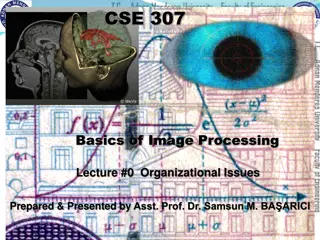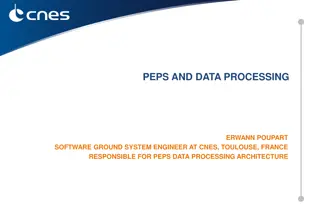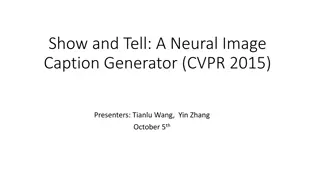Image Processing
Explore the fundamentals of computer vision and image processing, where images are converted into digital data for manipulation and analysis. Learn about digitizing analog video signals, representing digital images as 2D arrays, image resolution, and the human visual system. Delve into topics such as image brightness, pixel grids, gray levels, and the role of the human eye and brain in processing visual information.
Download Presentation

Please find below an Image/Link to download the presentation.
The content on the website is provided AS IS for your information and personal use only. It may not be sold, licensed, or shared on other websites without obtaining consent from the author.If you encounter any issues during the download, it is possible that the publisher has removed the file from their server.
You are allowed to download the files provided on this website for personal or commercial use, subject to the condition that they are used lawfully. All files are the property of their respective owners.
The content on the website is provided AS IS for your information and personal use only. It may not be sold, licensed, or shared on other websites without obtaining consent from the author.
E N D
Presentation Transcript
Image Processing SECOND lecture by Assit.Lec. Shaimaa Shukri
Chapter One Introduction to Computer Vision and Image Processing below we see one line of a video signal being sampled (digitized) by instantaneously measuring the voltage of the signal at fixed intervals in time. The value of the voltage at each instant is converted into a number that is stored, corresponding to the brightness of the image at that point. Note that the image brightness of the image at that point depends on both the intrinsic properties of the object and the lighting conditions in the scene. v o l t a g e Oneline ofinformation Time Digitizing (sampling) an analog videosignal One pixel Figure (1.5) Digitizing (Sampling ) an Analog Video Signal[1]. The image can now be accessed as a two-dimension array of data , where each data point is referred to a pixel (picture element).for digital images we will use the following notation : 7
Chapter One Introduction to Computer Vision and Image Processing I(r,c) = The brightness of image at the point (r,c) Where r= row and c= column. When we have the data in digital form, we can use the software to process the data . The digital image is 2D- array as: I(0,0) I(0,1) ..I(0,N-1) I(1,0) I(1,1) ..I(1,N-1) . I(N-1,0) I(N-1,1) . ..I(N-1,N-1) In above image matrix, the image size is (NXN) [matrix dimension] then: Ng= 2 m ..(1) Where Ng denotes the number of gray levels m, where m is the no. of bits contains in digital image matrix. Example :If we have (6 bit) in 128 X 128 image .Find the no. of gray levels to represent it ,then find the no. of bit in this image? Solution: Ng= 26=64 Gray Level Nb= 128 * 128* 6= 9.8304 * 104bit 6. The Human Visual System The Human Visual System (HVS) has two primary components: Eye. Brian. * The structure that we know the most about is the image receiving sensors (the human eye). 8
Chapter One Introduction to Computer Vision and Image Processing * The brain can be thought as being an information processing unit analogous to the computer in our computer imaging system. These two are connected by the optic nerve, which is really a bundle of nerves that contains the path ways for visual information to travel from the receiving sensor (the eye) to the processor (the brain). 1.7 Image Resolution Pixels are the building blocks of every digital image. Clearly defined squares of light and color data are stacked up ( ) next to one another both horizontally and vertically. Each picture element (pixel for short) has a dark to light value from 0 (solid black) to 255 (pure white). That is, there are 256 defined values. A gradient ( , ) is the gradual transition from one value to another in sequence. At the heart of any convincing photographic rendering is a smooth, seamless ( ) and beautiful gradation. In computers, resolution is the number of pixels (individual points of color) contained on a display monitor, expressed in terms of the number of pixels on the horizontal axis and the number on the vertical axis. The sharpness of the image on a display depends on the resolution and the size of the monitor. The same pixel resolution will be sharper on a smaller monitor and gradually lose sharpness on larger monitors because the same numbers of pixels are being spread out over a larger number of inches. Display resolution is not measured in dots per inch as it usually is with printers (We measure resolution in pixels per inch or more commonly, dots per inch (dpi)). 9
Chapter One Introduction to Computer Vision and Image Processing A display with 240 pixel columns and 320 pixel rows would generally be said to have a resolution of 240x320. Resolution can also be used to refer to the total number of pixels in a digital camera image. For example, a camera that can create images of 1600x1200 pixels will sometimes be referred to as a 2 megapixel resolution camera since 1600 x 1200 = 1,920,000 pixels, or roughly 2 million pixels. Below is an illustration of how the same image might appear at different pixel resolutions, if the pixels were poorly rendered as sharp squares (normally, a smooth image reconstruction from pixels would be preferred, but for illustration of pixels, the sharp squares make the point better). Figure (1.6) : Image Resolution . An image that is 2048 pixels in width and 1536 pixels in height has a total of 2048 1536 = 3,145,728 pixels or 3.1 megapixels. One could refer to it as 2048 by 1536 or a 3.1-megapixel image. 1.8 Image brightnessAdaption Brightness is intensity of light in simple words. Adaptation basically is "getting used to" and be comfortable with it. So conceptually brightness adaption is basically "getting used to changes in brightness/ changes 10
Chapter One Introduction to Computer Vision and Image Processing intensity of light". A simple example is when you go out into light from darkness you take some time to "get used" to the brightness outside and feel comfortable.This is what exactly is brightness adaption. In image we observe many brightness levels and the vision system can adapt to a wide range. If the mean value of the pixels inside the image is around Zero gray level then the brightness is low and the images dark but for mean value near the 255 then the image is light. If fewer gray levels are used, we observe false contours ( ) bogus lines resulting from gradually changing light intensity not being accurately represented. 9. Image Representation We have seen that the human visual system (HVS) receives an input image as a collection of spatially distributed light energy; this is form is called an optical image. Optical images are the type we deal with every day cameras captures them, monitors display them, and we see them [we know that these optical images are represented as video information in the form of analog electrical signals and have seen how these are sampled to generate the digital image I(r , c). The digital image I (r, c) is represented as a two- dimensional array of data, where each pixel value corresponds to the brightness of the image at the point (r, c). in linear image model I( r, c ) is referred to as a matrix , and one row ( or column) is algebra terms , a two-dimensional array likeour called a vector. The image types we will consider are: 1. Binary Image Binary images are the simplest type of images and can take on two values, typically black and white, or 0 and 1 . A binary image is 11
Chapter One Introduction to Computer Vision and Image Processing referred to as a 1 bit/pixel image because it takes only 1 binary digit to represent each pixel. These types of images are most frequently in computer vision application where the only information required for the task is general shapes, or outlines information. For example, to position a robotics gripper to grasp ( )an object or in optical character recognition(OCR). Binary images are often created from gray-scale images via a threshold value is, those values above it are turned white ( 1 ), and those below it are turned black ( 0 ). Figure (1.7) Binary Images. 2. Gray ScaleImage Gray _scale images are referred to as monochrome, or one-color image. They contain brightness information only , no color information. The number of different brightness level available. The typical image contains 8 bit/ pixel (data, which allows us to have (0-255) different brightness (gray) levels. The 8 bit representation is typically due to the fact that the byte, which corresponds to 8-bit of data, is the standard small unit in the world of digital computer. 12
Chapter One Introduction to Computer Vision and Image Processing Figure (1.8): Gray Scale Images. 3. ColorImage Color image can be modeled as three band monochrome image data, where each band of the data corresponds to a different color. Figure (1.9) : Color Images. The actual information stored in the digital image data is brightness information in each spectral band. When the image is displayed, the corresponding brightness information is displayed on the screen by picture elements that emit light energy corresponding to that particular color. Typical color images are represented as red, green , and blue or RGB images .using the 8-bit monochrome standard as a model , the 13
Chapter One Introduction to Computer Vision and Image Processing corresponding color image would have 24 bit/pixel 8 bit for each color bands (red, green and blue ). The following figure we see a representation of a typical RGB color image. IR(r,c) IG(r,c) IB(r,c) Figure (1.9) :Typical RGB color image can be thought as three separate images IR(r,c),IG(r,c),IB(r,c) [1] The following figure illustrate that in addition to referring to arrow or column as a vector, we can refer to a single pixel red ,green, and blue values as a color pixel vector (R,G,B ). Blue Green Red Figure (1.10) :A color pixel vector consists of the red, green and blue pixel values (R, G, B) at one given row/column pixel coordinate( r , c) [1]. 14
Chapter One Introduction to Computer Vision and Image Processing Figure (1.11) :A color pixel vector consists of the red, green and blue . For many applications, RGB color information is transformed into mathematical space that that decouples the brightness information from the color information. The hue/saturation /lightness (HSL) color transform allows us to describe colors in terms that we can more readily understand. The lightness is the brightness of the color, and the hue is what we normally think of as color and the hue (ex: green, blue, red, and orange). The saturation is a measure of how much white is in the color (ex: Pink is red with more white, so it is less saturated than a pure red). [Most people relate to this method for describing color}. Example: a deep, bright orange would have a large intensity ( bright ), a hue of orange , and a high value of saturation ( deep ).we can picture this color in our minds, but if we defined this color in terms of its RGB components, R=245, G=110 and B=20. Modeling the color information creates a more people oriented way of describing the colors. 15
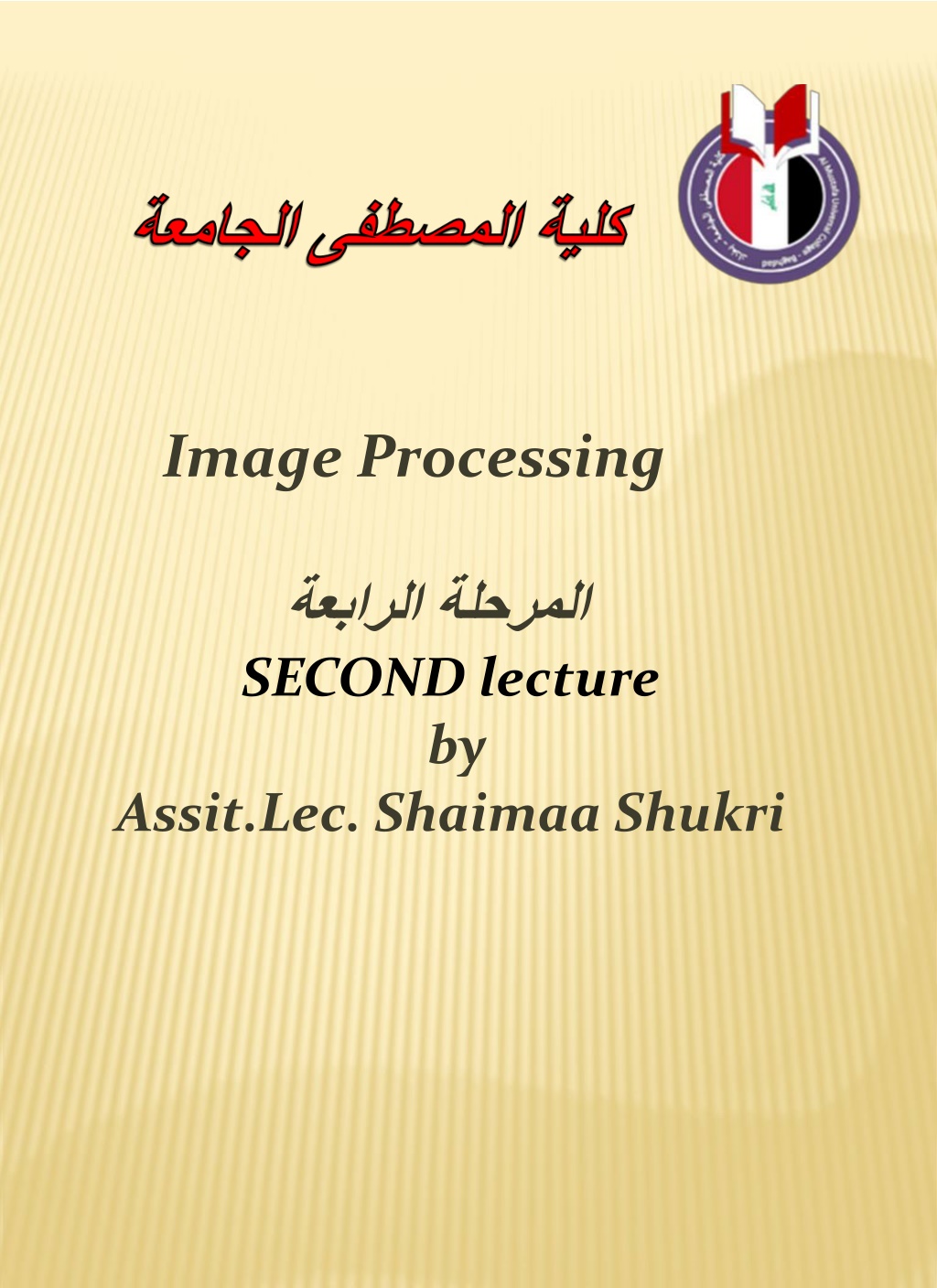
 undefined
undefined





